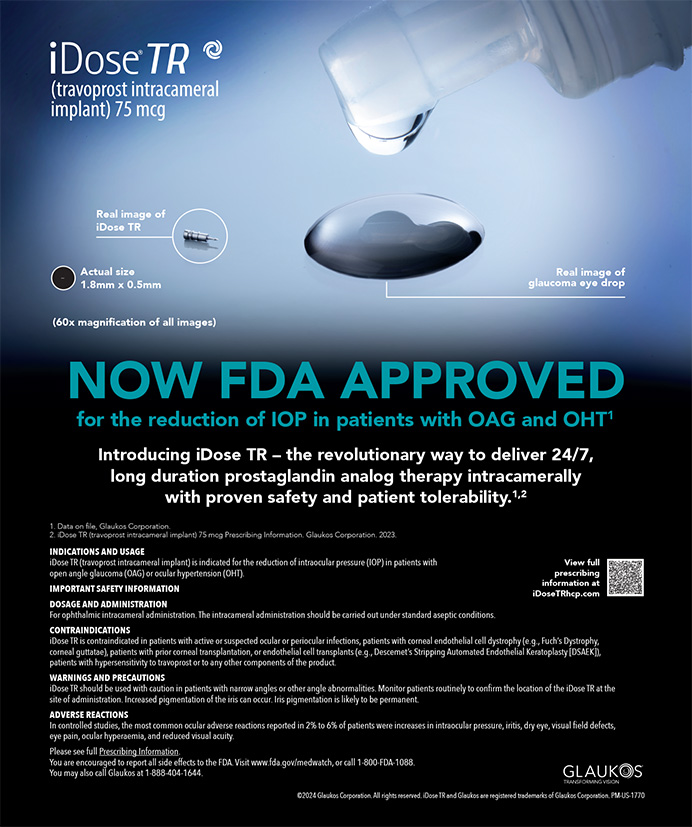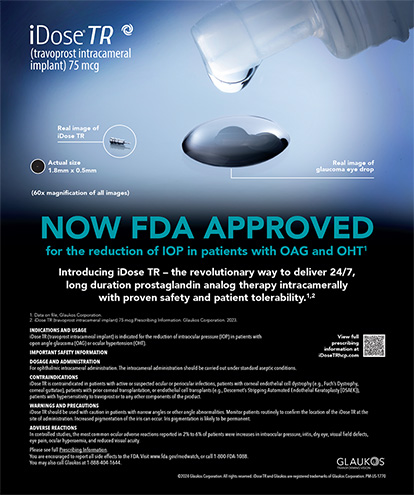Y. RALPH CHU, MD
My nurses instill tetracaine topically in the preoperative area before the dilating drops are applied and again before the eye is prepped in the OR. I prefer an intravenous (IV) sedation method and have found that patients respond well to IV fentanyl and midazolam. Although it is important to calmly guide patients through a procedure using “vocal local,” many patients experience more anxiety during their second eye procedure. When patients enter the OR to have their second eye operated on, they often remark, “I didn’t remember this from my first eye.” I have therefore found that propofol enhances their cooperation and relaxation during the second procedure. Using propofol is also effective in anxious patients, because its onset is quick, and the drug rapidly leaves their system. Although coughing can be a side effect of using propofol, I have observed the phenomenon in very few patients, and the symptoms were mild.
RANDALL E. COLE, MD
Over the past several years, I have been using a lowvolume, short-acting intraconal block, which has made surgery easier for my patients and me. The key to success is the anesthesia provider, and my ambulatory surgery center contracts with Renee M. Ceola, CRNA, who has performed more 8,000 intraconal eye blocks.
Using a 27-gauge, 1 1/4-inch needle, I administer 4 mL of 1% lidocaine with 1 unit of hyaluronidase per milliliter intraconally. This technique provides excellent anesthesia and akinesia, although having done topical cases, complete akinesia is not required. I implement monitored anesthesia care with IV fentanyl and midazolam (Versed; Hoffmann-La Roche Inc., Nutley, NJ) before the block and again at the start of the procedure, if needed. When the case is finished, the patient usually responds, “I didn’t know you started.”
Very difficult patients receive IV propofol, starting with 30 mg and titrated as needed. IV propofol is infrequently necessary and was recently unavailable, but it can be a helpful tool. I do not offer general anesthesia.
JAMES P. GILLS, MD
Anesthesia for a routine cataract surgery in my ambulatory surgery center consists of a topical anesthetic along with intracameral medications and monitored anesthesia care. Patients are premedicated with 5 to 10 mg of diazepam, and an IV reseal is inserted for monitored anesthesia care, which is only used in the event of high anxiety. My surgical team typically uses the following medications singularly or in combination: midazolam, fentanyl, ketamine, and propofol.
Sedation can be successfully managed in the majority of routine cases by following these steps. First, start topical anesthesia with a dilating gel, which is a combination of lidocaine 2% gel, dilating drops, antibiotics, and nonsteroidals. This combination allows the eye to be anesthetized and provides medications for surgery. Next, apply neutralized povidone-iodine solution along with topical lidocaine viscous 2% gel and proparacaine 0.5%. Finally, administer 0.25 to 0.5 mL of 1% intraocular, buffered lidocaine at the time of hydrodissection delineation.
I perform a peribulbar or retrobulbar block in very complicated cases or if additional surgeries are being performed concomitantly. I will also consider a block for extremely anxious patients or in the event that I am unable to communicate with a patient.
I believe there is a balance between using topical anesthesia versus peribulbar and retrobulbar blocks. The choice for each patient is individual and at the discretion of the surgeon. Although topical anesthesia is sufficient for most routine cataract surgeries, it is important that surgeons carefully determine which type of anesthesia is warranted for patients’ individual needs.
R. BRUCE WALLACE III, MD, AND D. SCOTT KING, CRNA
IV fentanyl and midazolam are the two topical medications we use most frequently for the sedation of patients undergoing cataract surgery. In most cases, these two medications work well together.
When the patient is overly anxious, we begin with the IV administration of a reduced dose of midazolam and fentanyl, followed by the titration of propofol in divided doses until satisfactory sedation is achieved. It is important, depending on the length of the procedure, to administer decreasing, continuous doses of propofol to avoid sudden, undesirable waking of the patient, which could result in a surgical complication.
Section Editor R. Bruce Wallace III, MD, is the medical director of Wallace Eye Surgery in Alexandria, Louisiana. Dr. Wallace is also a clinical professor of ophthalmology at the Louisiana State University School of Medicine and an assistant clinical professor of ophthalmology at the Tulane School of Medicine, both located in New Orleans. Dr. Wallace may be reached at (318) 448-4488; rbw123@aol.com. D. Scott King, CRNA, contracts with Dr. Wallace and may be reached at gt50068@aol.com.
Y. Ralph Chu, MD, is the founder and medical director of the Chu Vision Institute in Bloomington, Minnesota. Dr. Chu may be reached at (952) 835-0965; yrchu@chuvision.com.
Randall E. Cole, MD, is president of the BoozmanHof Regional Eye Clinic and founder and medical director of the BoozmanHof Eye Surgery and Laser Center, both in Bella Vista, Arkansas. He is a consultant to Abbott Medical Optics Inc. Dr. Cole may be reached at (479) 246- 1700; dreyerecole@aol.com.
James P. Gills, MD, is the founder and director of St. Luke’s Cataract & Laser Institute in Tarpon Springs, Florida. Dr. Gills may be reached at (727) 938-2020; jgills@stlukeseye.com.


